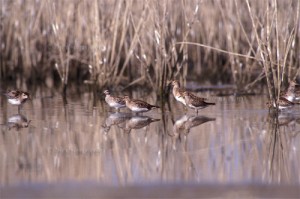 Early morning, 5:30 am. Haze over the water and I am watching through my camouflage tent here on the edge of Laguna Alalay on 2,600 m (asl). Waders are my main interest. At 4:30 am I got up already. The starry sky promised a nice day. In fact, at 5:00 am I pitched my tent in the dark. I pitched it on a site at the Laguna, which I had chosen yesterday. Great atmosphere. In the background the lights of the big city in the very first morning light. In the beginning there are no birds at the point at which I build the tent. But that’s probably better, since they are then at least not startled by me. Than the birds arrive. And the Birds are good. I can photograph as the first a Greater Yellowlegs (Tringa melanoleuca). Lesser Yellowlegs (Tringa flavipes) and even a lonely Solitary Sandpiper (Tringa solitaria) follow very soon. The best is a small flock of Pectoral Sandpiper (Calidris melanotos), which I have not seen before in Bolivia during the trip. First I see 1 individual, than some more and finally a flock of min. 15 individuals near the reeds of the lagoon. Wilson’s Phalarope (Phalaropus tricolor) were present in big swimming rafts in the middle of Laguna Alalay. Another North American migrant passed by flying over me, a Barn Swallow (Hirundo rustica). Finally, I twitched a Grassland Yellow-Finch (Sicalis luteola).
Early morning, 5:30 am. Haze over the water and I am watching through my camouflage tent here on the edge of Laguna Alalay on 2,600 m (asl). Waders are my main interest. At 4:30 am I got up already. The starry sky promised a nice day. In fact, at 5:00 am I pitched my tent in the dark. I pitched it on a site at the Laguna, which I had chosen yesterday. Great atmosphere. In the background the lights of the big city in the very first morning light. In the beginning there are no birds at the point at which I build the tent. But that’s probably better, since they are then at least not startled by me. Than the birds arrive. And the Birds are good. I can photograph as the first a Greater Yellowlegs (Tringa melanoleuca). Lesser Yellowlegs (Tringa flavipes) and even a lonely Solitary Sandpiper (Tringa solitaria) follow very soon. The best is a small flock of Pectoral Sandpiper (Calidris melanotos), which I have not seen before in Bolivia during the trip. First I see 1 individual, than some more and finally a flock of min. 15 individuals near the reeds of the lagoon. Wilson’s Phalarope (Phalaropus tricolor) were present in big swimming rafts in the middle of Laguna Alalay. Another North American migrant passed by flying over me, a Barn Swallow (Hirundo rustica). Finally, I twitched a Grassland Yellow-Finch (Sicalis luteola).
The day before, when I headed for Cochabamba I visited Laguna Alalay already. The laguna is located in Cochabamba department in the middle of Bolivia. Despite some human disturbance, the lake is attractive to many resident and migrant species of birds. In 2000 it was not clear, weather the lake would not be taken over slowly but surely from recreational activities. The “football fields” and other pastime activities (soccer clubs, other sports clubs and a golf course) pushed ever closer to the shore and let the shoreline shrink more and more. But it is understood that it is the constant availability of water in this dry environment at this altitude which makes Laguna Alalay a unique experience not only for birds. Right now, it seems that Laguna Alalay enjoys some protections as a Reserva natural.
Various species of North American migrating birds either pass through Bolivia or occur there throughout much of the austral summer. Some have been recorded there in the sixties of the last century during the northern breeding period. The status of many birds in Bolivia is still poorly known (see Dott 1984 for review of literature) but some scientific reviews have been written. This pattern is known from other migrating bird species as well. E.g. for the European Honey-buzzard (Pernis apivorus), where at least the most part of the 1st year birds stay in Africa instead of migrating back to Europe/ Asia. One of the best locations to observe North American migrants is the Laguna Alalay, mentioned above. I visited the lagoon in October 2000 (30th and 31st) and again on November 2nd. Laguna Alalay is a shallow water body at the edge of Cochabamba city. The shallow, oval lake, nearly one km long, is situated at approx. 2,600 m (asl) altitude. The lake – and the whole city – is located in a landscape where most species of plant have to adapt to survive in an environment with little water. Rain is said, to occur briefly, usually between December and March.
In order to meet the growing demand for top images of the rarer species of Palearctic Bird-lens.com has specifically made trips to remote places in Europe but also to other parts of the world. This to do everything to ensure excellent photos of the Birds of the Western Palearctic . The yield of pictures also of rare Western Palearctic birds is very good. The beautiful pictures of Andean birds of the family Laridae, that you see in the gallery are just first impressions of what you will find behind the tab “Picture- Store” very soon. Just give a notice if you need a picture of a bird before the new images are online.